[ú{ê/English]
Research Fields
- Research fields
- Key words
- dust grain
- supernova
- extinction curve
- presolar grain
- early unvierse
- optical to infrared observation
- supernova remnant
- chemical evolution
- massive star
- mass-loss wind
dust physics, theoretical astronomy, interstellar physics
Main Interests
- Formation and evolution of dust grains in the ejecta of supernovae
- Dynamics, destruction, and heating of dust grains in high-velocity shocks
- Evolution of grain size distribution in galaxies and interstellar extinction curves
- Origin of dust grains in the early unvierse and the roles of dust in star formation
- Formation of dust in stellar winds and mass-loss history at late phases of stellar evolution
- Origin and evolution of presolar grains
Recent Results
@Iron does not Exist as Pure Iron Grains in the Universe
It is considered that 99% of iron (Fe) atoms are incorporated into solid particles, called cosmic dust grains, in the interstellar medium.
However, the main composition of dust grains that lock up Fe atoms has not been specified.
The identification of the most common form of Fe is crucial in understanding the evolution history and inventory of dust grains in the universe.
A research group consisting of Hokkaido University, JAXA, and NAOJ replicated the formation of Fe grains in gaseous ejecta of evolved stars by means of microgravity experiments aboard the sounding rocket S-520-28.
They found that the sticking probability for the formation of Fe grains is extremely small, approximately 0.002%;
only a few atoms will stick per hundred thousand collisions so that homogeneous nucleation of metallic Fe grains is highly ineffective, even in the Fe-rich ejecta of Type Ia supernovae.
This implies that most Fe is locked up as grains of Fe compounds or as impurities accreted onto other grains in the interstellar medium.

[Figure] - Images of interference fringes during the Fe nucleation experiment under microgravity aboard the sounding rocket S-520-28.
In (a), the original image of the double-wavelength Mach-Zehnder-type laser interferometer is shown.
The color-separated images of the interference fringes in (a) are given in (b) for the green laser and in (c) for the red laser.
The temperature and partial pressure of Fe gas are determined simultaneously by observing shifts in the interference fringes of the two lasers.
The dotted line in (a) indicates the nucleation front of the Fe grains, above which interference fringes disappear due to scattering of light by abundantly formed Fe grains.
The scale bar corresponds to 2 mm.
This study was published in Science Advances on 19 Jan 2017.
"Pure iron grains are rare in the universe"
by Yuki Kimura, Kyoko, K. Tanaka,
Takaya Nozawa, Shinsuke Takeuchi, Yuko Inatomi
2017, Science Advances, 3, 1
[ Science Advances ]
[ pdf ]
[ press release@Hokkaido University ]
[ press release@JAXA ]
@Properties of Interstellar Dust Responsible for Extinction toward Type Ia Supernovae
Type Ia supernovae show the remarkable homogenity in terms of their absolute magnitude and spectral energy distribution.
Therefore, they are ideal objects not only for measuring the cosmic expansion as standard candles but also for extracting the extinction properties caused by dust existing along their sightlines.
However, extinction laws derived for Type Ia supernovae are much steeper than those observed for any lines of sight in our Galaxy.
In order to reveal the properties of interstellar dust that causes such steep extinction laws, we perform the fitting calculations to the measured extinction curves by applying a two-component dust model composed of graphite and silicate.
We find that the steep extinction curves as seen toward Type Ia supernovae can be reasonably explained even by the simple power-law grain size distribution that has a fixed power index of -3.5 with the maximum cut-off radii of 0.06-0.13 Êm.
These maximum cut-off radii are smaller than ~0.25 Êm considered to be valid in the Milky Way, clearly demonstrating that the interstellar dust responsible for steep extinction curves is highly biased to smaller sizes.
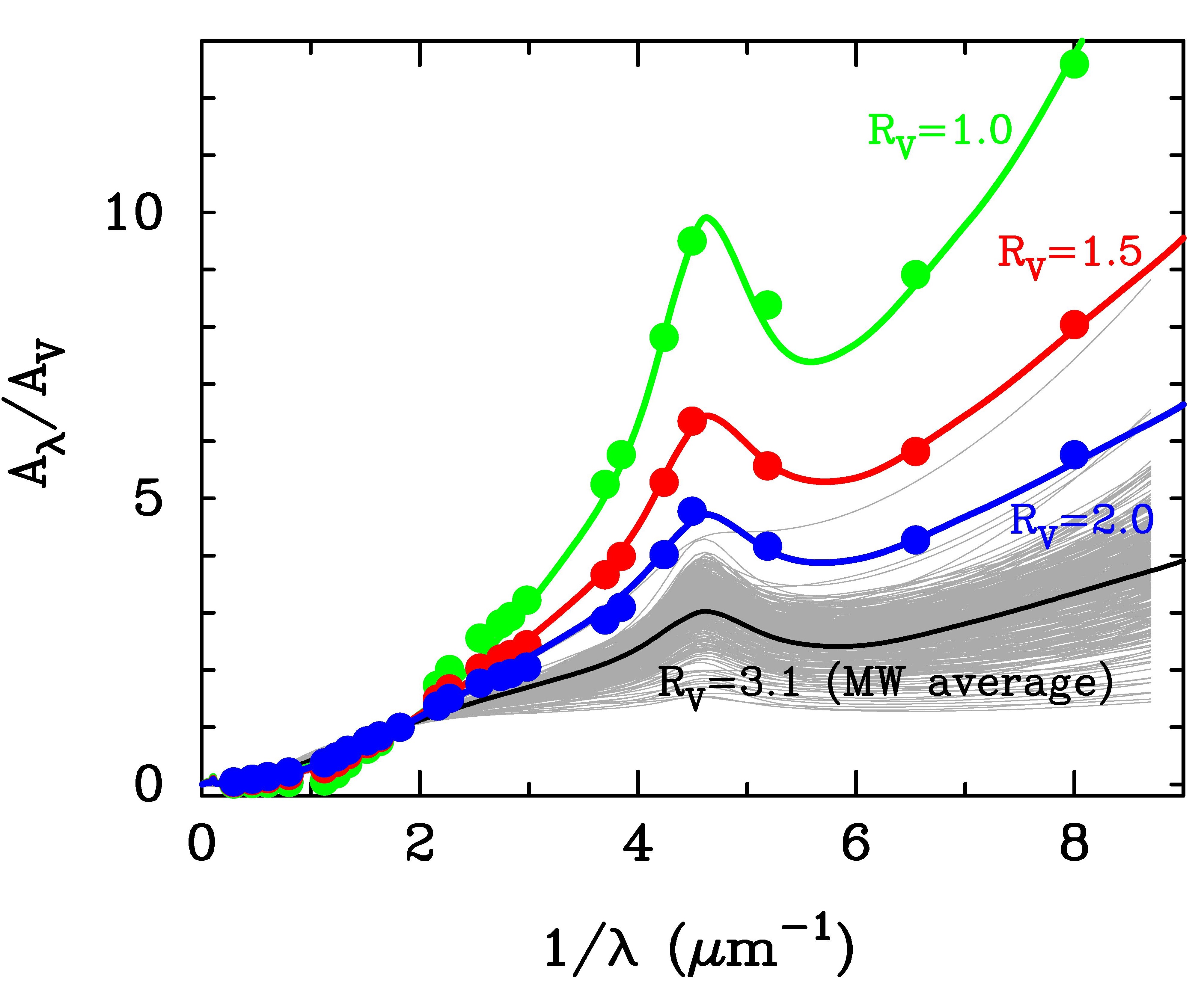
The figure shows the results of our fitting calculations.
The gray curves are the extinction curves observed for a variety of lines of sight in our Galaxy, whose average one is given by the thick black line (labelled as Rv=3.1).
The blue, red, and green dots, denoted as Rv=2.0, 1.5, and 1.0, respectively, are the extinction curves as suggested for Type Ia supernovae.
These steep extinction curves can be nicely reproduced by taking the maximum cut-off of grain radii as 0.13 Êm, 0.09 Êm, and 0.06 Êm, respectively.
This study was published in Planetary and Space Science (special issue for Cosmic Dust VIII)
on 21 Nov 2016.
"Properties of Interstellar Dust Responsible for Extinction Laws
with Unusually Low Total-to-selective Extinction Ratios of Rv = 1-2"
by Takaya Nozawa
2016, Planetary and Space Science (special issue for Cosmic Dust VIII), 133, 36-46
[ ADS ]
[ pdf ]
@Probing the Stellar Explosions with the Sizes of Presolar Al2O3 Grains
Presolar grains, which are discovered in meteorites, are solid particles that
are considered to have been produced before the formation of Solar System.
A few particles of presolar Al2O3 grains with sizes above 0.5 um are believed
to have been originated in the ejecta of core-collapse supernovae (SNe).
With the aim of clarifying the formation condition of such large Al2O3 grains,
we investigate the condensation of Al2O3 grains for wide ranges of the gas
density and cooling rate.
We find that the formation of submicron-sized Al2O3 grains requires at
least 10 times higher gas densities than those presented by one-dimensional
SN models.
This indicates that presolar Al2O3 grains might be formed in dense gas clumps
and that the measured sizes of presolar grains can be a powerful tool for
constraining the physical conditions of SN ejecta.
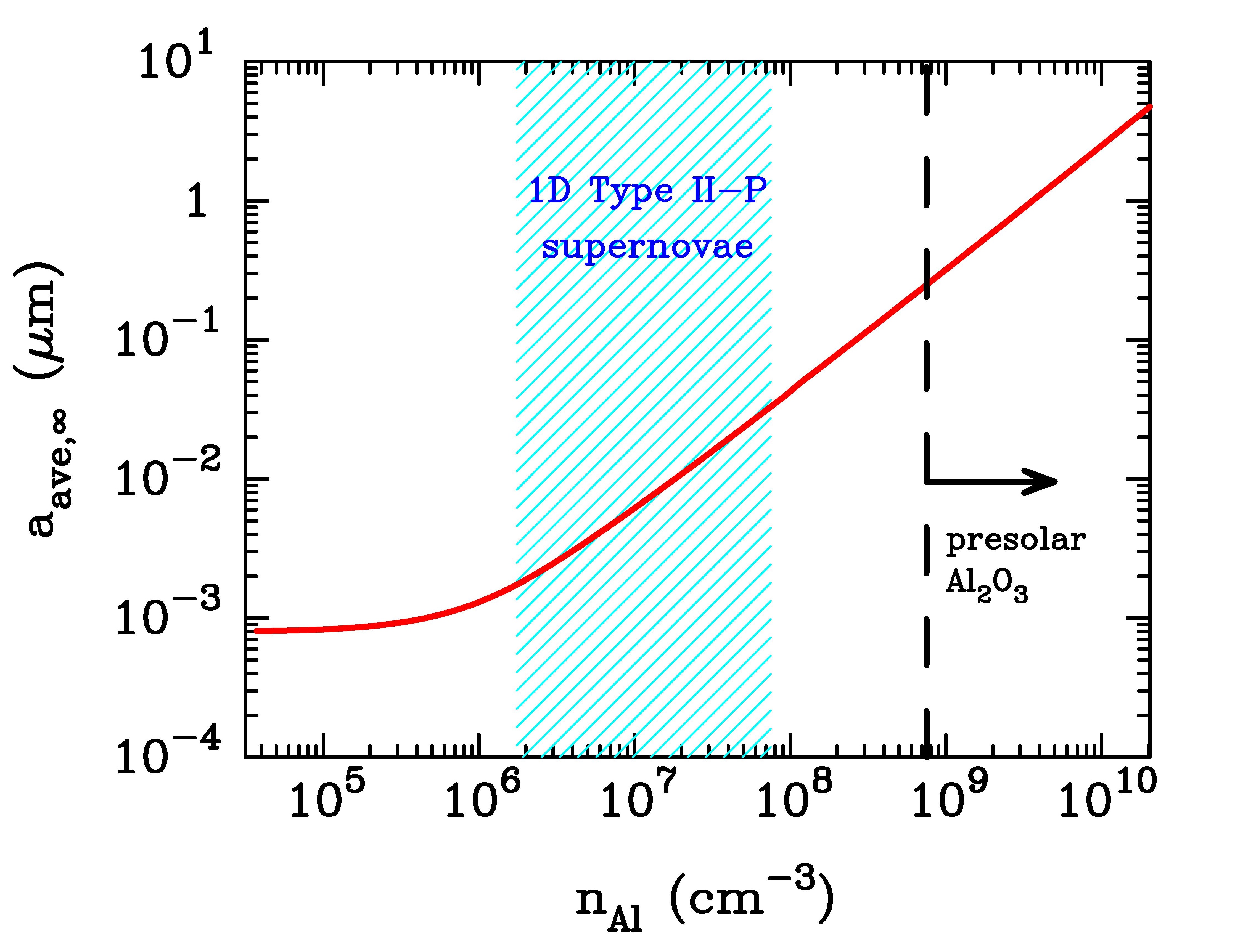
The figure plots the calculated average radius of newly formed Al2O3 grains
as a function of number density of Al atoms (red line);
the average grain radius increases with increasing the number density of Al atoms.
The hatched region depicts the expected ranges of the Al density in the ejecta,
referring to a one-dimensional model of a Type II-P SN (Kozasa et al. 2009).
The dashed vertical line denotes the minimum Al density necessary for
explaining the measured sizes (radius of 0.25 um) of presolar Al2O3 grains.
This study was published in The Astrophysical Journal Letters on 5 Oct 2015.
"Probing the Physical Conditions of Supernova Ejecta with the
Measured Sizes of Presolar Al2O3 Grains"
by Takaya Nozawa,
Shigeru Wakita, Yasuhiro Hasegawa, Takashi Kozasa
2015, The Astrophysical Journal Letters, 811, L39 (5pp)
[ ADS ]
[ pdf ]
@Revealing Large Amounts of Dust and Unusual Extinction
Curves in the Early Unvierse
There are many pieces of evidence that the extinction curves of quasars at
redshifts above z=5 are different from those at low-z quasars and that a
huge amount of dust is present in their host galaxies. These indicate that
the early interstellar medium was rapidly enriched with dust grains, whose
properties are quite unusual.
We investigate the evolutions of dust content and extinction curve in a
high-z quasar, based on the state-of-the-art dust evolution model that takes
account of grain size distribution. We show that the massive amounts of dust
and the peculier extinction curves in high-z quasars can be naturally
explained if a large fraction of the interstellar medium is in dense
molecular-cloud phases, where efficient grain growth and coagulation occur.
We also find that the major composition of carbonaceous dust in high-z dusty
galaxies is amorphous carbon rather than graphite. These results indicate
the differences in the properties of dust and in the condition of the
interstellar medium between low-z and high-z galaxies.
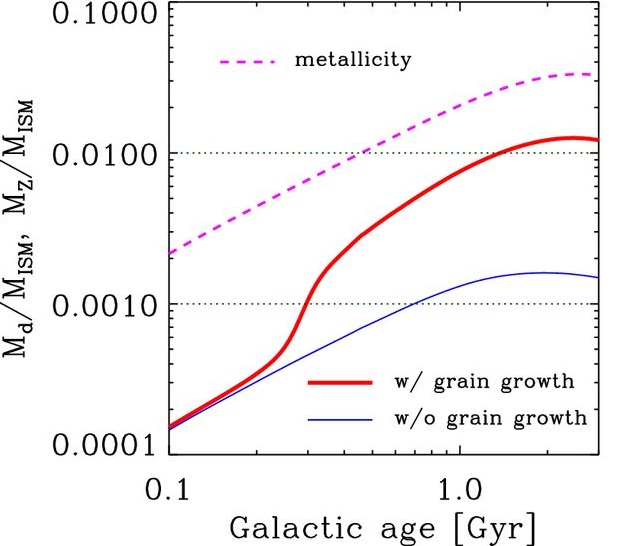
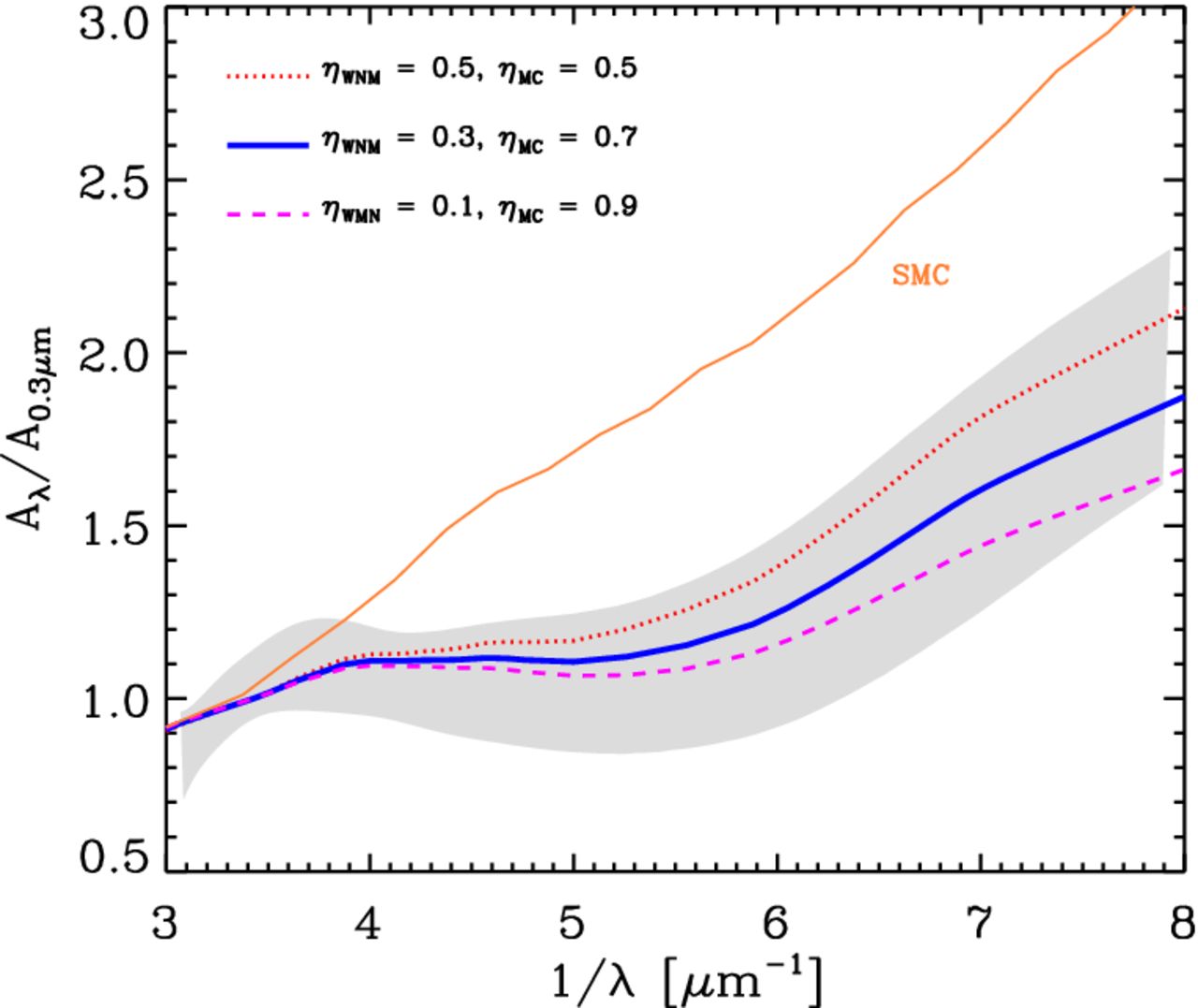
[Left] - Time evolutions of dust-to-gas mass ratios (solid) and metallicity
(dashed) obtained from the dust evolution model in a high-z galaxy.
The case with grain growth (red solid) can reach the observed high dust-to-gas
mass ratio (0.01), while the case without grain growth (blue solid) cannot.
[Right] - Calculated UV extinction curves at t = 1 Gyr. The dotted, thick
solid, and dashed lines show the results for the mass fraction of
the molecular-cloud phase, 0.5, 0.7, and 0.9, respectively.
The hatched region is the range of the extinction curve for the high-z
quasar J1048+4637 at z = 6.2 (Maiolino et al. 2004).
For comparison, the SMC extinction curve is drawn by the thin solid line.
This study was published in Monthly Notices of the Royal Astronomical Society Letters
on 27 Nov 2014.
"Evolution of grain size distribution in high-redshift dusty quasars:
integrating large amounts of dust and unusual extinction curves
by Takaya Nozawa,
Ryosuke S. Asano, Hiroyuki Hirashita, Tsutomu T. Takeuchi
2015, MNRAS Letters, 447, L16-L20
[ ADS ]
[ pdf ]
@Formation of Carbon Grains in Very Massive Primordial Stars
Since the beginning of this century, the presense of huge amounts of dust grains has been confirmed at the times around one tenth of the present cosmic age.
Since then, the origin of cosmic dust in the early universe has been hotly debated.
We investigate the formation of dust in a stellar wind during the red-supergiant phase of a very massive first star with the zero-age main sequence mass of 500 times the solar mass.
We find that such a very massive star can produce, at most, one solar mass (300000 times the earth mass) of carbon grains in total during its lifetime.
This indicates that, if the first stars are very massive as suggested by many studies, then they can be the first important sources of small solid particles in the universe.
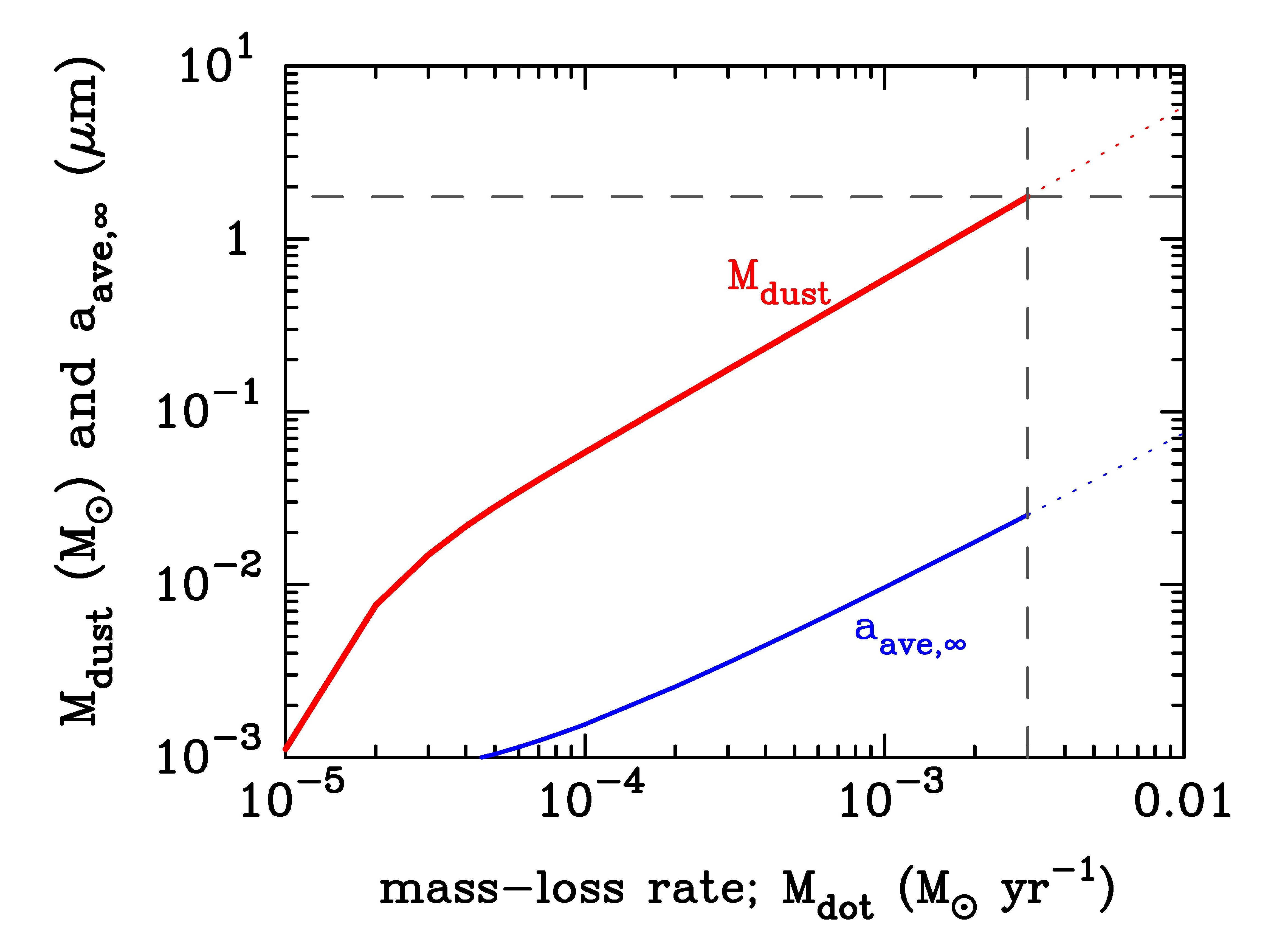
The figure plots the total mass of carbon grains formed during the evolution of a very massive first star whose initial mass is 500 times solar mass, as a function of mass ejection rate.
The figure shows that, for the mass ejection rate of 0.003 solar mass per year, 1.7 times solar mass of carbon grains can form in total with the average radius around 0.02 micrometer.
This study was published in The Astrophysical Journal Letters on 9 May 2014.
"Dust Production Factories in the Early Universe: Formation of Carbon Grains in
Red-Supergiant Winds of Very Massive Population III Stars
by
Takaya Nozawa,
Sung-Chul Yoon, Keiichi Maeda, Takashi Kozasa, Ken'ichi Nomoto, Norbert Langer
2014, The Astrophysical Journal Letters, 787, L17 (5pp)
[ ADS ]
[ pdf ]